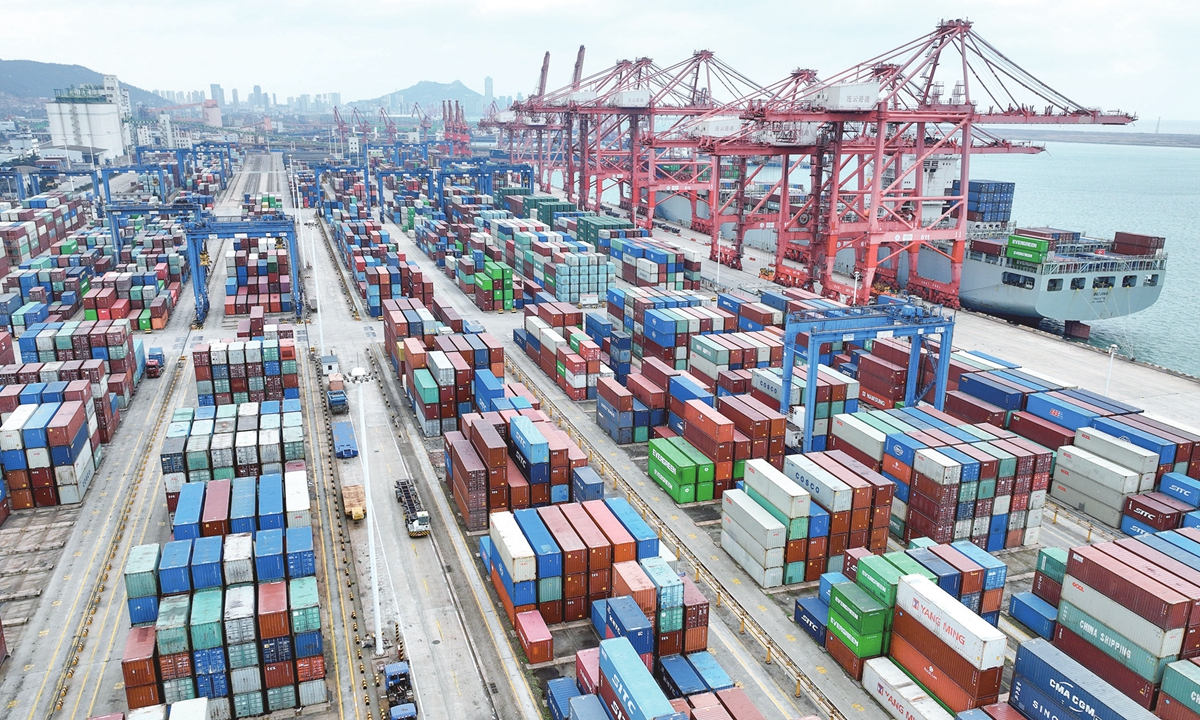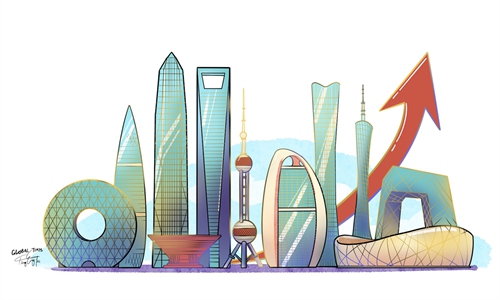In a tough 2022, China’s economic governance inspires stability, US protectionism wreaks havoc globally

People enjoy leisure time at a business center in Beijing, capital of China, Dec 24, 2022. In recent days, business areas in Beijing have bustled again as the epidemic prevention and control measures have been optimized in line with the evolving epidemic situation. Photo:Xinhua
China's ultra-efficiency in policymaking and implementation has been on full display in the last week of 2022. After the nation's top health authority on Monday night announced it will downgrade management of COVID-19 and lift quarantine requirements on inbound travelers from January 8, 2023, various ministries responsible for everything from customs and immigration to foreign affairs swiftly moved to remove anti-COVID measures in their respective areas, essentially reopening China's borders after three years of arduous fight against COVID pandemic.
The successive announcements sparked widespread joy among Chinese travelers, many foreign businesses and even some countries that rely heavily on revenue from Chinese outbound tourism, underscoring growing confidence in China's efforts to shift gear in its COVID policy to get out of the haze of the pandemic and mount a swift, robust economic recovery. Thanks to the adjusted anti-epidemic measures and stepped-up pro-growth policies, the robust economic rebound further took shape over the past week or so, as cities which have gone through the COVID-19 infection peak bustled once again with droves of consumers and businesses rushing to catch up on orders before the holidays.
The final week of the year is a microcosm of how China has carefully formulated and executed anti-epidemic and economic policies, not only helping the country beat back several severe waves of COVID-19 and other challenges, protecting public health to the greatest extent, securing livelihoods and ensuring overall economic stability in 2022, but also making great contributions to global efforts to tackle various crises.
The opposite has been seen in Washington. 2022 marked another year of relentlessly intensifying US unilateralism, protectionism and hegemonism that created or exacerbated some of the global crises of the past year. Internally, the US' failed policies, particularly monetary policy, created decades-high inflation and brought the US economy to the cusp of recession. Externally, the US' unilateral sanctions, crackdowns and "decoupling" moves became a source of chaos for the world.

A worker is busy in a workshop of Harbin Turbine Company Ltd. of Harbin Electric Corporation in Harbin, northeast China's Heilongjiang Province, May 7, 2022. Photo:Xinhua
Economic performance
In economic terms, 2022 was a tough year for all countries, as the lingering COVID-19 pandemic continued to affect businesses, while the Russia-Ukraine conflict and ensuing Western economic sanctions seriously disrupted global food and energy supplies and exacerbated the overall economic situation, and extreme weather in many parts of the world also severely impacted local and global economic activity. However, in the face of these profound challenges, some economies fared much better.
"Despite many downward trends, China has basically maintained the strength of its economy, the basic capacity of production and the whole of society's expectation for the upward trend of China's economic development," Cao Heping, an economist at Peking University, told the Global Times, noting that despite the slower growth pace, China's economic output is expected to reach a whopping 120 trillion yuan ($17.2 trillion) in 2022, an impressive outcome given the multiple challenges.
While GDP figures for the last quarter of 2022 have not yet been released, China's economy saw an impressive V-shaped recovery in the past three quarters. The growth rate hit 4.8 percent in the first quarter despite a high base last year, then dropped to 0.4 percent in the second-quarter amid severe waves of COVID-19 outbreaks in major economic powerhouses including Shanghai, and recovered to 3.9 percent in the third quarter thanks to swift and effective pro-growth measures.
The headline GDP growth doesn't fully capture the performance of the Chinese economy in 2022. Numerous indexes and anecdotes also point to the resilience of the Chinese economy. China avoided the cost-of-living crisis seen in many major economies, particularly in the US and Europe, with its consumer price index staying at 1.6 percent in November, compared to 7.1 percent in the US and 10.1 percent in the euro zone. China also avoided a food crisis seen in many parts of the world, with grain output hitting a new record of 686.53 billion kilograms in 2022. China also avoided an energy crisis seen in Europe with increased supply, particularly expansion in clean energy generation, which is expected to hit 3,000 terawatt-hours, far more than any other country.
Meanwhile, foreign investment continues to pour in, with foreign direct investment in actual use growing nearly 10 percent in the first 11 months. Exports also saw stable growth despite weak external demand, with certain higher-end products leading the trend. Car exports, for example, grew by 55.3 percent in the first 11 months.
In stark contrast, other major economies, including the US, fared poorly over the past year. According to the IMF's latest projections released before China's adjusted anti-COVID measures, China's GDP growth rate of 3.2 percent - lower than many economists expected - will be higher than the US' 1.6 percent rate and 3.1 percent in the euro area. Meanwhile, both the US and Europe have been seeing decades-high CPI, despite their aggressive rate hikes to tame inflation. Both the US and the euro zone are facing a growing risk of falling into recession in 2023.
Contrasting policymaking
While various factors such as the different development stages and challenges they face contributing to the starkly contrasting economic performances of China and the US in 2022, the difference in their ability to formulate and execute sound policies and ultimately the efficiency of their economic governance systems has been one decisive factor, analysts noted.
"China's economic policy stresses openness, while the US is the opposite, with an emphasis on protectionism and decoupling from China, which is essentially a full attack on multilateralism," He Weiwen, a former senior trade official and an executive council member of the China Society for World Trade Organization Studies, told the Global Times.
Behind China's hard-won economic achievements over the past year is the ability of the Chinese government to promptly and effectively formulate and implement a long list of both short-term and long-term economic policies as well as swiftly make adjustments based on new situations and challenges.
In March, facing downward pressure starting in the last quarter of 2021, the Government Work Report vowed "arduous efforts" to realize "medium-high growth" in 2022, including monetary, fiscal and other measures to boost growth, which ensured that the growth rate in the first quarter of 2022 accelerated by 0.8 percentage points from the previous quarter. As second-quarter growth slowed to 0.4 percent, China released 33 measures to boost growth in May and followed up with another 11 pro-growth measures in July, which ensured the rebound in third quarter growth to 3.9 percent.
Meanwhile, a series of documents and meetings focusing on long-term economic goals, including the guideline on establishing a unified domestic market released in April, the report to the 20th National Congress of the Communist Party of China in October, and the Central Economic Work Conference as well as the guideline aimed at further expanding demand consumption released in December, also provided a clear direction of economic development and offered policy transparency, continuity and predictability, which are essential for local officials and domestic and foreign businesses, analysts noted.
"Every time we faced a new epidemic outbreak, the government has always moved to stabilize production and expectations. And the role of the government as the backbone of the country is solid because the public feels the people-centered approach," Cao said.
Over the past year, the US has not only failed to tackle its challenges through its domestic economic policymaking, but has also intensified its protectionist and confrontational policies, both of which have wreaked havoc around the world.
The US' U-turn on monetary policy from essentially unlimited money-printing to aggressive rate hikes affected global capital flows due to its dollar hegemony and even caused debt crises in developing countries such as Sri Lanka. The US' so-called Inflation Reduction Act, which offers exclusive subsidies for various products made in North America, has even angered its European and Asian allies. Meanwhile, the US has introduced ever more sanctions, export bans and crackdown measures against businesses from countries such as Russia and China over the past year, essentially rubbing salt on the wounds of the global economy.
"US protectionism has actually sparked global anger," Cao said, noting that the US' moves not only hurt other countries including US allies such as Japan and the EU, but will also "make itself suffer in the coming years."

Containerships dock at the terminal of Lianyungang port in East China’s Jiangsu Province on December 4, 2022. Official data showed that Lianyungang port's cargo throughput reached 270 million tons from January to November, a year-on-year increase of 8.32 percent. Photo: VCG
'Bright spot and solid anchor'
Unlike the US, China over the past year not only focused on stabilizing its domestic economy but also helped promote global economic and trade cooperation to jointly tackle global challenges, analysts noted.
In January, China and 14 other Asian-Pacific countries implemented the world's biggest trade pact, the Regional Comprehensive Economic Partnership (RCEP) Agreement, with the value of China's trade with its RCEP partners increasing 7.9 percent year-on-year in the first 11 months, higher than that with the US. China has also been actively pushing forward its application to join the Comprehensive and Progressive Agreement for Trans-Pacific Partnership as well as the Digital Economic Partnership Agreement.
China has also steadily expanded its network of economic and trade partners over the past year through major initiatives and events such as the Belt and Road Initiative and the first China-Arab States Summit and the first China-Gulf Cooperation Council Summit. China has also improved relations with main trade partners that are also close US allies, such as Germany and Australia.
"Strengthening such economic and trade ties between China and such regions will form support for our foreign trade," Tian Yun, former vice director of the Beijing Economic Operation Association, told the Global Times, noting that such efforts will also greatly help the global economy and trade development.
Moreover, China's widely expected economic recovery in 2023 will make greater contributions to global growth, Tian said, noting that the speed of China's adjustment to its epidemic response and the length of this adjustment period have both exceeded expectations, which means China's economy is on track for a speedy recovery.
"For next year, everyone's expectation is that China's economy will be the major bright spot in the world and solid anchor of global economy," Tian said.


